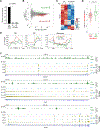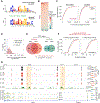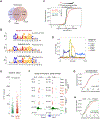Jpx RNA regulates CTCF anchor site selection and formation of chromosome loops
- PMID: 34856126
- PMCID: PMC8671370
- DOI: 10.1016/j.cell.2021.11.012
Jpx RNA regulates CTCF anchor site selection and formation of chromosome loops
Abstract
Chromosome loops shift dynamically during development, homeostasis, and disease. CCCTC-binding factor (CTCF) is known to anchor loops and construct 3D genomes, but how anchor sites are selected is not yet understood. Here, we unveil Jpx RNA as a determinant of anchor selectivity. Jpx RNA targets thousands of genomic sites, preferentially binding promoters of active genes. Depleting Jpx RNA causes ectopic CTCF binding, massive shifts in chromosome looping, and downregulation of >700 Jpx target genes. Without Jpx, thousands of lost loops are replaced by de novo loops anchored by ectopic CTCF sites. Although Jpx controls CTCF binding on a genome-wide basis, it acts selectively at the subset of developmentally sensitive CTCF sites. Specifically, Jpx targets low-affinity CTCF motifs and displaces CTCF protein through competitive inhibition. We conclude that Jpx acts as a CTCF release factor and shapes the 3D genome by regulating anchor site usage.
Keywords: 3D genome; CTCF; CTCF release factor; CTCF site selection; Jpx RNA; chromatin loop; chromosome conformation; gene activation; loop anchors; noncoding RNA.
Copyright © 2021 Elsevier Inc. All rights reserved.
Conflict of interest statement
Declaration of interests J.T.L. is a cofounder of Fulcrum Therapeutics and an advisor to Skyhawk Therapeutics.
Figures







Comment in
-
RNA releases CTCF from chromatin.Nat Cell Biol. 2022 Jan;24(1):1. doi: 10.1038/s41556-021-00828-1. Nat Cell Biol. 2022. PMID: 35027738 No abstract available.
References
-
- Augui S, Filion GJ, Huart S, Nora E, Guggiari M, Maresca M, Stewart AF, and Heard E (2007). Sensing X Chromosome Pairs Before X Inactivation via a Novel X-Pairing Region of the Xic. Science 318, 1632–1636. - PubMed
-
- Bell AC, and Felsenfeld G (2000). Methylation of a CTCF-dependent boundary controls imprinted expression of the Igf2 gene. Nature 405, 482–485. - PubMed
-
- Berkower I, Leis J, and Hurwitz J (1973). Isolation and characterization of an endonuclease from Escherichia coli specific for ribonucleic acid in ribonucleic acid-deoxyribonucleic acid hybrid structures. J Biol Chem 248, 5914–5921. - PubMed
Publication types
MeSH terms
Substances
Grants and funding
LinkOut - more resources
Full Text Sources
Other Literature Sources
Molecular Biology Databases

